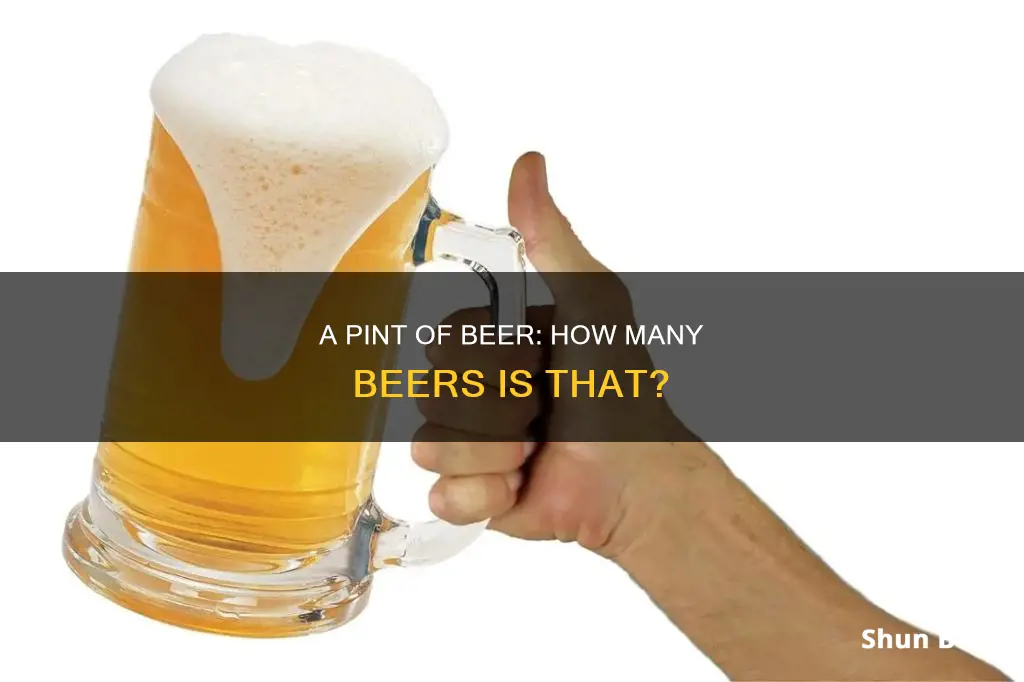
How many beers are in a pint? It's a simple question, but the answer is surprisingly complicated. A US pint is 16 ounces, and a standard US beer serving is 12 ounces. So, a US pint is equivalent to approximately 1.33 beers. However, this calculation assumes that the average alcohol by volume (ABV) of the beer is around 5%, and the ABV of beer can vary significantly. For example, a typical lager has an ABV of 4-6%, while IPAs can have an ABV of 7-10%. Additionally, the size of a pint varies depending on the country. In the UK, Ireland, and most European countries, a pint is 568 ml, while in the US, a pint is 473 ml.
What You'll Learn

A US pint is 16 ounces
When it comes to beer, the number of servings in a pint can vary depending on several factors, including the type of pint and the serving size of the beer in question. In the United States, a standard beer serving is typically 12 ounces, with most cans or bottles of beer sold in multi-packs adhering to this size. However, the definition of a "pint" may differ depending on the context.
A US pint is defined as 16 ounces, which translates to 1.25 cans or bottles of standard beer servings. This means that if you order a pint of beer at a bar or restaurant, you should receive approximately 1.25 servings. However, it's important to note that the actual volume of beer in a "pint" glass can vary, and you may sometimes receive less than a full pint.
The discrepancy in the volume of beer served in a pint glass can be attributed to the use of "cheater pints" or “shaker” glasses in some establishments. These glasses are designed to look like standard pint glasses but have a reduced capacity, typically holding only 14 ounces or less. This practice may be unintentional, as cheaper glasses with thicker walls and bases can unintentionally reduce the volume of beer served. However, some unscrupulous operators may also use glasses with extra-thick bottoms to deliberately shortchange customers.
To address this issue, some states and cities in the US have considered implementing laws and regulations to ensure that customers receive a true 16-ounce pint when ordering a beer. Additionally, there are educational campaigns aimed at raising awareness among both consumers and servers about the actual volume of beer they are receiving.
In summary, while a US pint is indeed 16 ounces, the serving size of beer in a pint glass may sometimes be less than the full volume. This variation in serving size can be influenced by the type of glass used and the practices of the establishment serving the beer. To ensure you're getting your money's worth, it's always a good idea to be mindful of the volume of beer you're being served and to support establishments that provide honest pints.
Budlight vs Amber Beer: Taste, Color, and Alcohol Content
You may want to see also

A UK pint is 20 ounces
A UK pint is 20 fluid ounces, or 568 millilitres. This is about 20% larger than the American pint, which is 16 fluid ounces or 473 millilitres.
The number of beers in a pint depends on the size of the bottles or cans. In the US, a standard beer serving is 12 ounces, or 355 millilitres, so a US pint is equal to about 1.3 beers. In the UK, a standard beer serving is also assumed to be 12 ounces, so a UK pint is equivalent to about 1.66 beers.
However, the actual amount of beer served in a pint glass may be less than the full volume of the glass. In the US, it is not uncommon for bars to serve 14-ounce pints, and in the UK, a typical pint glass may be served with only 18 ounces of beer.
In some countries, the term "pint" is used to refer to different volumes of beer. For example, in South Australia, ordering "a pint of beer" will result in 425 millilitres (15 fluid ounces) being served, while customers must specifically request "an Imperial pint of beer" to receive the full 570 millilitres (20 fluid ounces).
Beer Nuts vs Peanuts: What's the Difference?
You may want to see also

A pint is 1.33 standard beers
A pint of beer is a standard unit of measurement in the beer universe. In the United States, a pint is 16 ounces or 473 millilitres, and the typical glass is conical, with a smaller base than top. However, the size of glasses varies from bar to bar. In the US, a standard beer serving is 12 fluid ounces, so there are 1.33 standard beers in a pint, assuming an average alcohol by volume (ABV) of 5%.
It's worth noting that the ABV of beer can vary significantly depending on the type. For example, a typical lager contains 4-6% ABV, while an IPA might have 7-10% ABV. So, the number of beers in a pint can also depend on the type of beer you're drinking. Lighter ales and lagers with lower ABVs are suitable for drinking multiple pints, while beers with higher ABVs, like pale ales and pilsners, should be sipped slowly.
The concept of a pint varies globally. For instance, an imperial pint in the UK is 20 fluid ounces or 568 millilitres. In Canada, a pint is also 20 ounces, and it's illegal to call anything less than 19.5 ounces a pint. In Australia, a pint equals 474 millilitres, or 568 millilitres in South Australia. These variations in pint size can lead to surprises when ordering a beer in different countries.
When it comes to serving sizes, different establishments may serve beer in volumes ranging from 12 to 16 ounces. The higher end of that range corresponds to a US pint, a popular option for many bars. The lack of strict laws governing serving sizes allows for this flexibility in the beer world.
Beer Carbonation: CO2 Content Varies by Brew
You may want to see also

A pint glass may not be a pint
Firstly, the definition of a pint varies between the US and the UK. In the US, a pint is defined as 16 US fluid ounces (473 millilitres), while in the UK, an imperial pint is 20 imperial fluid ounces (568 millilitres). This discrepancy means that a US pint glass will appear noticeably smaller to someone accustomed to UK pint measures.
Secondly, the shape and size of pint glasses can vary, and this affects the actual volume of beer they can hold. The most common pint glass shapes include the conical or sleever glass, the nonic glass, the jug glass or dimple mug, the tulip glass, and the can-shaped glass. Each of these designs has unique features that impact their capacity and functionality. For example, the nonic glass, with its distinctive bubble or bulge, typically holds between 16 and 20 fluid ounces, but can also be found in smaller sizes.
Additionally, the way beer is served can result in a pint glass not actually containing a full pint. Beer is typically served with a head of foam, which takes up a portion of the glass. In the UK, a court ruling in 1982 stipulated that the head should not occupy more than half of the glass, and legislation was later passed to allow a pint to contain 95% liquid beer and 5% head. This means that a "pint" of beer may, in reality, be slightly less than a full pint due to the presence of the foamy head.
Furthermore, the serving size of a pint can be impacted by the practices of establishments serving beer. In some cases, bars and restaurants have been known to use smaller glasses or underfill pint glasses, resulting in customers receiving less beer than they expect. This issue has led to consumer complaints and, in some cases, legislative action to protect customers from being short-served.
Lastly, cultural and regional variations can also influence the size of a "pint." For example, in Canada, Federal law mandates the use of the standard imperial pint, but this is not always enforced, and establishments sometimes sell US pints or other measures as "pints." Similarly, in Australia, beer is formally measured in metric units, but draught beer is commonly ordered and sold in glasses approximating imperial measures, with a "pint" in South Australia referring to a smaller 425-millilitre (3/4 pint) glass.
In conclusion, while the term "pint" may evoke a standard measure of beer, the actual volume of beer in a pint glass can vary due to differences in definitions, glassware, serving styles, and regional practices.
The Perfect Pint: Beer's Liquid Measure
You may want to see also

A bottle of beer is 12 ounces
A bottle of beer is typically 12 ounces in the US, though the amount of beer in a bottle can vary depending on the brand. For example, Brahma from Brazil contains 355ml, while some other imports are only 330ml. The amount of liquid in a bottle or can of beer does not necessarily reflect the amount of alcohol it contains.
In the US, a standard drink or alcoholic drink equivalent contains around 14 grams of alcohol. This is found in 12 ounces of regular beer, which is usually about 5% alcohol. Therefore, a 12-ounce bottle of beer in the US is considered a standard serving.
However, the actual amount of beer in a pint glass can vary. While a US pint is 16 ounces, a typical pint glass may only be filled with 14 or 18 ounces of beer. Additionally, an imperial pint in the UK is 20 ounces.
To complicate matters further, the alcohol content of beers in the US can vary widely. Historically, most beers in the US were 3-5% ABV, but with the rise of craft brewing, beers can now have a much higher alcohol content.
So, while a 12-ounce bottle of beer is a standard serving in the US, the number of bottles of beer in a pint can vary depending on the size of the pint glass and the alcohol content of the beer.
Learn to Order Beer in Many Languages
You may want to see also
Frequently asked questions
There are approximately 1.33 beers in 1 pint, assuming the average alcohol by volume (ABV) of the beverage is around 5%.
A regular (U.S.) pint glass holds 16 fluid ounces, while an imperial (UK) pint glass holds 20 fluid ounces, meaning an imperial pint contains approximately 25% more liquid than its American counterpart.
A US fluid pint equals 16 ounces, while an imperial pint in the UK is 20 fluid ounces.







